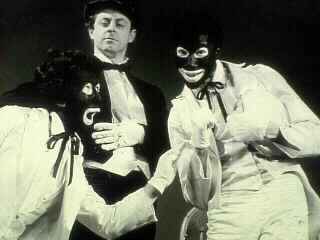Fifth Estate Collective
The San Francisco Mime Troupe
And now ladies and gentlemen...
The San Francisco Mime Troupe is preparing for its third annual cultural assault on Detroit. Presented by this newspaper, the guerrilla theatre group whose home ground is the public parks of San Francisco and Berkeley, will present a new commedia dell’arte play, “The Farce of Patelin,” at Upper DeRoy Auditorium on the WSU campus, October 25, 26, 27 at 8:00 p.m.
“Patelin” tells the story of two schemers, each of whom, in trying to cheat the other, gets caught in his own web, and a simpleton, who turns out to be the master schemer. The play depicts the world of man as ruled by jungle law, and the characters’ resemblance to various animals is not accidental.
The play is adapted from a 15th century French farce and is directed by Sandra Archer.

The Mime Troupe, founded in 1959 by its director, R.G. Davis, toured the country in 1966 with its black and white minstrel show, “Civil Rights in a Cracker Barrel,” and was followed by a storm of abuse and a wave of repression on the part of college officials, police, and legislators. The production, sponsored by the American Civil Liberties Union, played to a full house in Detroit in October of 1966.
During the escalation of draft resistance activity last fall, the Troupe’s anti-pacifist, anti-war satire, “L’Amant Militaire” was enthusiastically received on campuses across the country. This production played in Detroit last Fall under the auspices of this paper and stirred up a minor controversy when some of the audience claimed that a portrayal of one character was anti-Semitic. A rebuttal of the charge was easily made in the pages of the Fifth Estate by the Troupe when answering a letter from one offended patron.
Commedia dell’arte (Italian popular comedy) is a stylized form of broad comedy, much of it often improvised, originated by roving players of the Renaissance. It is performed by actors on a portable stage, bare except for a painted backdrop: the acting style is broadly farcical, the action often bawdy.
The actors double as stagehands and musicians; it is theatre stripped to its bare essentials. It is clearly suited to the aims of a company which, in Davis’s words, “wants to have the same relation to its audience as the guerrilla does to the community which aids him in his struggle.”
The Mime Troupe performs regularly in the public parks of the San Francisco Bay Area and survives on collections taken after each performance. The idea is to abolish walls, including the fifth wall, money.
Outdoor performance, says the Troupe, heightens the challenge to the actor: sky, dogs, and ball games compete for the attention of an audience which, having invested nothing in advance, will not hesitate to leave if it is bored. “People are more demanding when they don’t pay,” declares a Troupe actress.
At the same time the Troupe affirms its right to be paid, and frequently admonishes the audience, “Not quarters—dollars!”
“We want people to understand,” they say, “that this is our work not a spare time amusement. Often someone will say ‘Great show—sure looks like fun—what do you people do?’ When we tell him this is what we do, he gets confused.”
The point is that, yes, you can have work you enjoy: and it’s better to have work you enjoy than to have a barbecue in the backyard and a color TV.
